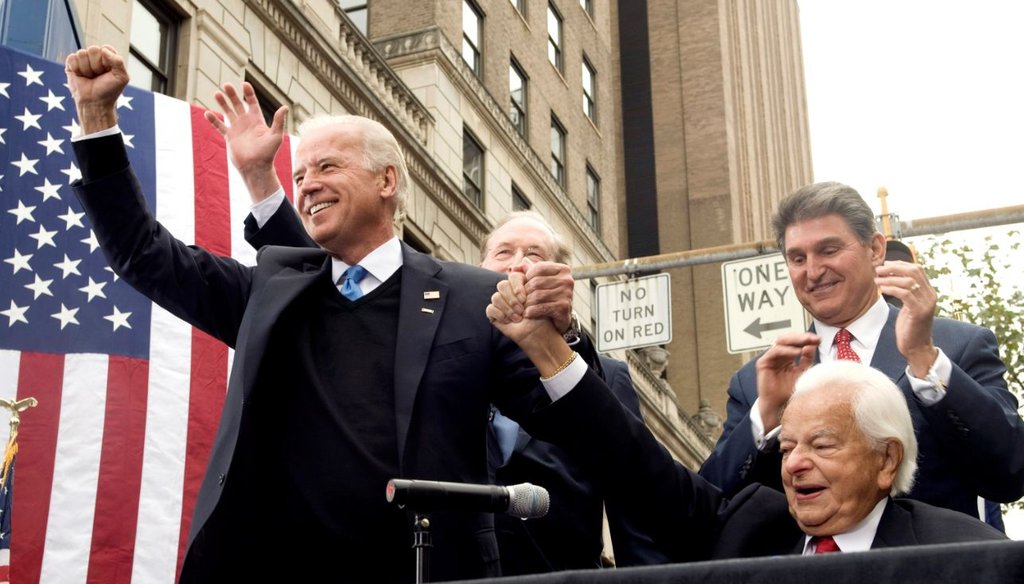Get PolitiFact in your inbox.

Then-Democratic vice presidential candidate Joe Biden accompanied by Sen. Robert Byrd, D-W.Va., in Charleston, W.Va., on Oct. 24, 2008. (AP)
If Your Time is short
• Budget reconciliation is a process that allows passage of some legislation with only 51 votes in the Senate, rather than the 60 that would be needed if the opposition filibusters.
• It’s been used more in recent years, because partisan polarization has made it hard to secure 60 votes for high-profile but potentially controversial bills.
• The Biden administration and Democrats in Congress hope to use it in the coming weeks to pass major spending to fight COVID-19.
Reconciliation — even by the standards of legislative procedures, its name is almost comically dry. But the budget reconciliation process is poised to provide President Joe Biden with his best shot of passing something approximating his $1.9 trillion American Rescue Plan, a proposal to contain the coronavirus crisis and the resulting economic downturn.
But what is budget reconciliation? Put simply, it’s a process for passing a certain type of fiscal legislation with just a simple majority of 51 Senate votes — rather than the 60 that would be needed if the opposition filibusters. The Democrats have 51 votes if Vice President Kamala Harris is called upon as a tie-breaker. So if Democrats stay united, they can push Biden’s agenda through.
Biden and his Democratic allies in the Senate don’t have to use reconciliation to pass the American Rescue Plan. They could instead hammer out a compromise that wins the backing of at least 10 GOP senators. In the currently tied chamber, that would reach the 60-vote threshold needed to sidestep a filibuster, and it would burnish Biden’s campaign pledge to operate in a bipartisan manner.
However, in an era of intense partisan polarization, securing 10 votes from the opposite party is no easy task. So most observers predict that Democrats will eventually turn to reconciliation instead.
The lower vote threshold has made reconciliation the go-to strategy for both parties in recent years. It was used by Republicans during the Trump administration to try — unsuccessfully — to repeal the Affordable Care Act and to enact — successfully — a big tax overhaul bill. It was also used to enact tax cuts under President George W. Bush and the Affordable Care Act under President Barack Obama.
"Because of the way the filibuster has been weaponized in the last 20 years or so, majorities have searched for procedural outlets to enact their policy priorities, and reconciliation has become one such outlet," said Josh Ryan, a Utah State University political scientist.
Here’s an explanation of how reconciliation works.
The budget reconciliation process was written into the Congressional Budget Act of 1974 as a tool for lawmakers, but wasn’t used until 1980. Since then, it’s been used to produce a law 25 times, all but four of which were eventually signed by the president.
In the big picture, the idea of budget reconciliation is to use a two-step process for federal budgeting. The first step is to pass a blueprint that gives an outline of budgetary goals. The second step is passage of a bill to "reconcile" those broad revenue-and-outlay goals into detailed implementing legislation.
"The purpose of the reconciliation process is to enhance Congress’s ability to bring existing spending, revenue, and debt limit laws into compliance with current fiscal priorities and goals established in the annual budget resolution," the Congressional Research Service has written.
It’s somewhat ironic that the reconciliation process was initially intended to serve as a tool to help reduce the deficit, given that it may be used this year to enact $1.9 trillion in new spending. However, such uses of reconciliation have become common, even routine, in recent years.
The first step is to pass an identical budget resolution through both chambers of Congress that includes "reconciliation instructions" — guidance for committees about how much to reduce the deficit in their areas, or how much to cap spending increases. While reconciliation instructions do not have to be included in a budget resolution, they are required if lawmakers want to use the reconciliation process.
The passage of a budget resolution in both houses was completed on Feb. 5. While that resolution does not go to the president for his signature, any subsequent legislation produced through reconciliation does eventually go to the president.
The next step is for lawmakers to hammer out what specific elements go into a reconciliation bill. Individual committees, especially the Budget Committee, play a role in this process, as do party leaders.
Once the legislation is assembled, it is subject to another significant step: Challenges under the "Byrd rule."
This is a rule proposed by the late Sen. Robert Byrd, D-W.Va., that was designed to keep budget reconciliation bills focused on topics related to national finances, so that they’re not overloaded with extraneous issues.
Applying the rule to a provision in the bill could result in it being removed. One disqualifier would be if the provision doesn’t change the level of spending or revenues, or does so only incidentally. Another would be if a provision raises deficits outside of the "budget window" covered by the legislation, typically 10 years. Changes to Social Security are also considered out of bounds.
On the floor, any senator can raise a "point of order" against a provision in the reconciliation bill. Once an objection is raised, the nonpartisan Senate parliamentarian decides whether the provision is OK to stay in the bill. The presiding senator is obligated to follow that ruling.
However, the Senate may choose to preempt the parliamentarian’s ruling by offering a motion to waive the ruling. That takes a three-fifths vote — a steeper threshold than the simple majority the bill itself will ultimately require.
One example from Biden’s American Rescue Plan that could draw a point of order is raising the minimum wage to $15. The relevant question under the Byrd rule would be whether raising the minimum wage affects federal revenues or spending.
Once debate on a reconciliation bill starts, it is limited to 20 hours, a short time by Senate standards. A simple majority is required to pass the bill. If the House and Senate pass different versions, they must be reconciled either by a joint House-Senate conference committee or by amending one chamber’s version to match the other’s. Debate on the final compromise version is limited to 10 hours.
Officially, it’s possible to split up the three categories of bills envisioned in the 1974 law — spending, revenues, and debt — into three separate reconciliation bills per year. But as a practical matter, those issues overlap, making it hard to produce reconciliation bills that deal with just one of those topics. So the standard practice is to produce no more than one reconciliation bill per fiscal year.
However, it’s possible for Democrats to offer two reconciliation bills in the current calendar year. That’s because the previous Congress did not pass a budget resolution. So there’s one reconciliation process available today to cover fiscal year 2021, and another one available this fall for fiscal year 2022, which starts on Oct. 1.
Tere’s precedent for doing this: The GOP-controlled Congress offered two reconciliation bills in 2017.
So Biden and the Democrats could try to pass the American Rescue Plan pursuant to the fiscal 2021 budget resolution, and then pursue a second reconciliation bill later in the year.
Historically, reconciliation bills have taken anywhere from a month to a year to finish, but this year, there’s a deadline of sorts: March 14, when higher unemployment benefits are set to lapse. Since continuing unemployment benefits is a key part of Biden’s American Rescue Plan, the bill’s backers would like to see those benefits continue uninterrupted, and that would take enactment of a bill by early March.
Our Sources
Congressional Research Service, "The Budget Reconciliation Process: Stages of Consideration," Jan. 25, 2021
Congressional Research Service, "The Budget Reconciliation Process: The Senate’s 'Byrd Rule,'" Dec. 1, 2020
Center on Budget and Policy Priorities, "Introduction to Budget 'Reconciliation,'" Jan. 21, 2021
Vox.com, "The Senate vote-a-rama gets Democrats closer to approving Covid-19 relief on their own," Feb. 4, 2021
The Hill, "Little known Senate referee to play major role on Biden relief plan," Feb. 4, 2021
Email interview with Donald R. Wolfensberger, director of the Congress Project at the Woodrow Wilson International Center for Scholars, Feb. 5, 2021
Email interview with Steven S. Smith, political scientist at Washington University in St. Louis, Feb. 5, 2021
Email interview with Josh Ryan, Utah State University political scientist, Feb. 5, 2021














































